Woodyard D. (ed.) Pounders Marine diesel engines and Gas Turbines
Подождите немного. Документ загружается.

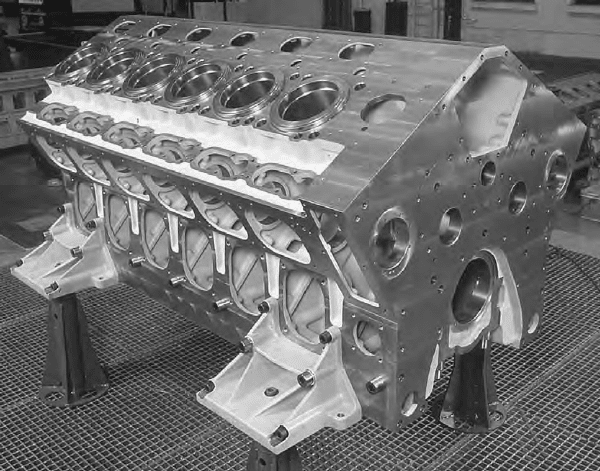
The cylinder unit also benefited from solutions validated in other Wärtsilä
designs, notably: a plateau-honed cast iron cylinder liner incorporating an anti-
polishing ring at the top to eliminate bore polishing; a composite piston (steel
crown and aluminium alloy skirt) with a three-ring pack (two hard chromium-
plated compression rings and one spring-loaded oil scraper ring) and optimized
cooling; and Wärtsilä’s patented piston skirt lubrication system. The piston is
lubricated by an oil jet, which also supplies oil to the cooling gallery in the pis-
ton top (Figure 30.41).
The forged high-tensile steel connecting rods are fully machined and bal-
anced for low vibration running, and designed to facilitate oil lubrication to
the small end bearings and pistons. The big end has a diagonal split with ser-
rated teeth. Two stud screws are hydraulically tensioned and can be accessed
through the inspection doors at the engine sides. An offset split makes its pos-
sible to overhaul the piston and connecting rod assembly through the cylinder
liners.
The strong 220 mm diameter forged high-tensile steel monobloc crank-
shaft (Figure 30.42) has gas-nitrided surfaces for added safety and a high
degree of balancing from two bolted counterweights per crank throw. The gen-
erous diameters of both crankpin and journal achieve a large bearing surface
while allowing a reduced cylinder spacing ratio (1.5 times the bore) to mini-
mize engine length and weight. The crankshaft is fitted with counterweights
Wärtsilä 821
FigurE 30.41 the nodular cast iron block of the Wärtsilä W200 engine incorporates
uid channels
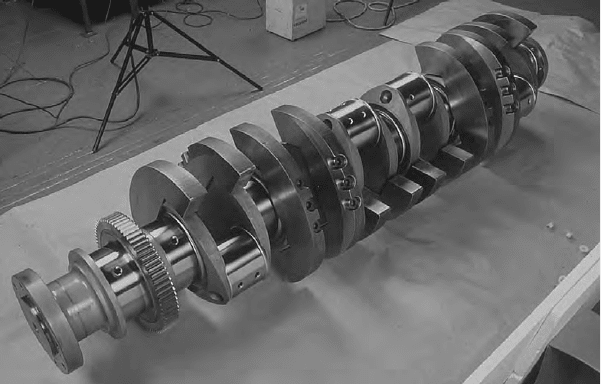
822 High-Speed Engines
and fully balanced, and the oil seal can be changed without removing the
crankshaft. The running surfaces of the crankpin and main journal are hard-
ened, and the connecting rod big end bearings and main bearings are of the
CuPb type.
Supporting the loads generated by the high injection pressure, the well-
dimensioned camshafts are formed from modular sections bolted together,
each section serving two or three cylinders; the sections can be removed axi-
ally from the engine block. The cams are surface hardened for wear resistance.
Located on both sides of the engine block, the camshafts are driven by timing
gearwheels arranged inside the engine block at the flywheel end.
Among the measures designed to ease inspection and maintenance are:
cylinder heads hydraulically tightened with four stud screws on the cylinder
block; and connecting rod big ends and main bearing caps fastened by two
hydraulically tightened studs.
Fuel injection starts slightly before TDC so that combustion takes place
during the beginning of the expansion phase in lower temperatures. The com-
bination of a high compression ratio (16:1) and late fuel injection fosters low
NOx generation without raising fuel consumption since the engine’s injection
period at 1500 rev/min is sufficiently short. Applying this low NOx principle
(see Chapter 27) required the engine to be able to inject fuel late in the cycle
and over a short duration without undermining performance: HP capacity
injection equipment was therefore dictated. The engine was released for opera-
tion on marine diesel oil (ISO 8217, F-DMX to FDMB).
Individual fuel injection pumps are integrated in the same cast multi-hous-
ing (Figure 30.43) as the inlet and exhaust valve tappets and the inlet and out-
let fuel connections, and can be removed directly without touching the housing
or any piping. The coated pump plungers are designed for pressures up to
FigurE 30.42 the Wärtsilä W200 engine crankshaft has gas-nitrided surfaces
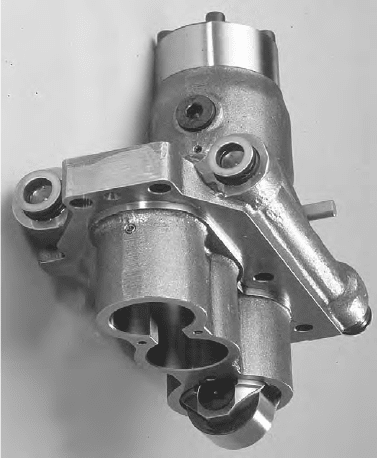
2000 bar and for a high flow capacity. Fuel is injected into the cylinder through
a nitrided eight-hole nozzle designed to yield optimal performance in combi-
nation with the combustion bowl and swirl level, and to ensure good resist-
ance to wear and thermal loads. The feeding parts are optimized to eliminate
the risk of cavitation. Injection timing is adjusted from the camshaft drive. The
injection pumps are equipped with pneumatic emergency stop pistons which
are activated to switch the fuel racks to the zero position by a signal from the
engine overspeed detector or safety stop contacts.
An important contribution to engine performance is made by the cooling
water system which can be divided into LT and HT circuits with separate out-
lets and inlets for the HT and LT sides, or configured as a single circuit with
an HT outlet from the engine and return to the LT side. The cooling system
comprises: a preheating module; double-impeller cooling water pump for LT/
HT circuits; thermostatic valves and LT/HT water mixing; charge-air cooler;
lube oil cooler; sea water pump (optional); and cooling circuitry mostly incor-
porated in the engine block casting. The external system normally comprises
a plate-type heat exchanger for cooling the engine water and another smaller
plate-type unit for fuel cooling.
The LT system cools both the charge air and the lubricating oil; the
charge-air and oil coolers are placed in parallel to achieve maximum cooling
efficiency. Increased engine component reliability is reported due to the low
lubricating oil temperature (70°C after cooler), and reduced NOx emissions
due to the cold charge-air temperature (60°C after cooler). The HT system
Wärtsilä 823
FigurE 30.43 the fuel injection pump of Wärtsilä’s W200 engine is integrated in the
multi-housing
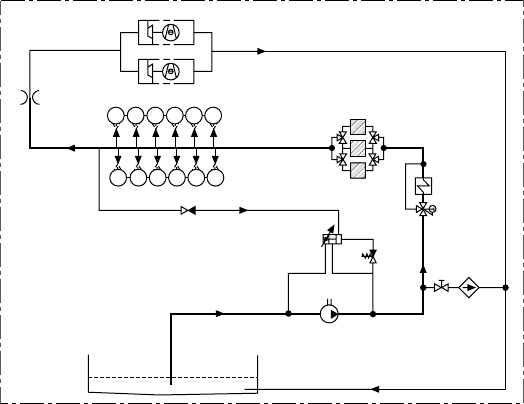
824 High-Speed Engines
cools the engine block and also the first stage of the charge air when optional
maximized waste heat recovery on the HT line is specified.
The main elements of the lubricating oil system (Figure 30.44) are: a wet
oil sump; lube oil pump module (comprising engine-driven oil pump and elec-
trically driven pre-lubrication pump); lube oil module (comprising thermostati-
cally controlled lube oil cooler and main filters); centrifugal filter; distribution
channels integrated in the engine block; oil jet nozzles for piston cooling and
lubrication; and instrumentation. Pre-lubrication can be controlled automati-
cally or manually.
Integration of lubricating oil, fuel oil and cooling equipment in modules
mounted on the engine achieves a significant reduction in external connections:
only two for water, two for fuel oil and one for starting air. The lubricating
oil filters can be changed one by one, even while the engine is running, using
a three-way valve to interrupt the oil flow to the filter chamber. The chamber
is drained externally by a tap and cleaned without risk of contaminating the
lubricating oil system. The system is equipped with a bypass centrifuge fil-
ter, located to facilitate ease of maintenance while the engine is running. The
washable cell-type air filters are mounted on top of the engine and fixed with a
quick clamping arrangement.
The lubricating oil pump, electrically driven pre-lubricating pump, cool-
ing water pump, fuel pump and optional priming fuel pump, and sea water
pump are all mounted externally at the free end of the engine. The fuel pump
is placed on the same shaft as the lubricating oil pump. The twin water pump
for both LT and HT cooling water circuits has only one shaft for both circuits;
this means fewer gearwheels need checking and less changing of bearings and
sealings. The pre-lubricating pump can also be used for draining the oil sump.
Turbochargers
Throttle
Main filters
Oil cooler
Centrif.
filter
Lube oil pump
Oil sump
Engine
FigurE 30.44 lubricating system of W200 engine
An engine flywheel housing of multi-functional design supports starters
and turning gear, and conveys fluids between the different modules. The start-
ing motor is of the pneumatic type, operating effectively even at LP.
Marine versions of the W200 engine were originally turbocharged with
four automotive-derived turbochargers but these were later replaced by ABB
or Holset marine models. The 12V200 models subsequently featured twin tur-
bochargers arranged at the free end of the engine.
The
1500 rev/min engines in service suffered some failures in 1998–1999
owing to lube oil circuit problems and material issues, but design refine-
ments and an improved manufacturing process eliminated the main causes.
Lubricating circuit performance was upgraded by a better oil filter module
design and main lube oil pump, allowing ‘fail-safe’ cartridge replacement and
a constantly clean and air-free oil flow. The connecting rod big end assembly
was thoroughly re-engineered to secure the highest reliability. The engine top
overhaul period for 1500 rev/min engines (50 Hz gensets) was extended from
12 000 h to 18 000 h in 2002.
automotivE-DErivED EnginES
Marinized automotive-derived high-speed engines are popular for small craft-
propulsion and genset drives on larger ships, where their ruggedness and reli-
ability (based on numerous truck applications) are appreciated.
Swedish truck engine specialist Scania launched its most powerful-ever
marine engine in 2001, the DI16M design replacing the long-established
DI14M series. The new 16-litres engine exploited an extra 2 litres of dis-
placement in a package that was both shorter and lower than its forerunner.
Increased torque and lower emissions were also delivered by the DI16M, a
twin-turbocharged V8-cylinder design offered with commercial power ratings
from 338 kW to 590 kW at speeds from 1800 rev/min to 2200 rev/min. The
highest rating addressed light-duty applications such as patrol boat propulsion;
ratings from 440 kW to 590 kW (medium-duty/high-power commercial) served
pilot, police and rescue vessels; and the lower output range was applied for
heavy-duty commercial propulsion (tugs, workboats, fishing vessels).
The DI16M was the first Scania marine engine to use electronic unit injec-
tors (EUIs) and the company’s new S6 fully electronic engine management
control module. EUI allows fuel injection timing to be adjusted to suit all
engine running conditions, from cold start to idling and throughout the power
range. The system fosters improved power output, fuel economy and emission
control, with reduced exhaust smoke.
Based on Scania’s 16-litres truck engine, the 127 mm bore/154 mm stroke
DI16M shared the same separate four-valve cylinder heads, cylinders and valve
mechanism as its smaller sibling, the DI12M. New composite pistons featured
aluminium bodies and steel crowns to handle the high combustion pressure.
The engine measures 1.25 m long 1.178 m wide 1.15 m high overall, and
has a dry weight of 1500–1600 kg, depending on its equipment.
automotive-derived engines 825
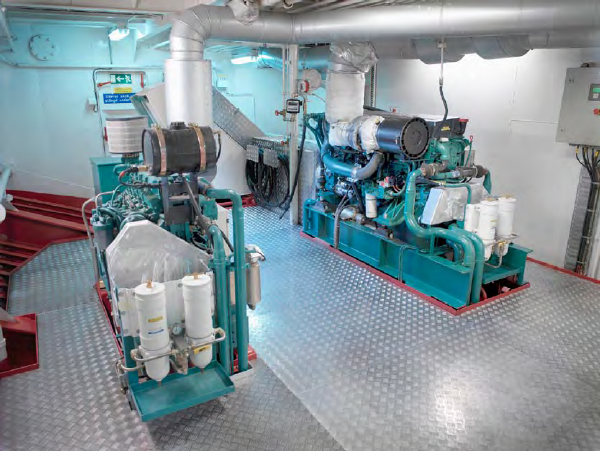
826 High-Speed Engines
Scania’s current 12- and 16-litres engines, respectively in-line V6- and
V8-cylinder versions of a 127 mm bore/154 mm stroke design, are offered in a
range of ratings for propulsion duties. The power band extends from 221 kW at
1800 rev/min for continuous service to 588 kW at 2200 rev/min for patrol craft/
short service applications. Intermittent service and patrol craft/long service rat-
ings between these limits can also be specified for the engines which are popu-
lar for small ferries, rescue boats, fishing vessels, and pilot and patrol craft.
An electronic engine management system in combination with EUIs fos-
ters optimum combustion and enables data to be collated and processed every
micro-second to regulate injection timing and fuel quantity injected. Precision
in controlling these parameters, together with a high injection pressure, pro-
motes lower fuel consumption and emission levels, including compliance with
IMO, EU Stage IIIA, US EPA Tier II and CCNR Stage II regulations.
Low emissions were high priority for another Swedish specialist, Volvo
Penta, when designing its 16-litres TAMD 165 automotive-based marine
engine. The in-line six-cylinder model benefited from an upgraded fuel injec-
tion pump and a new injector as well as a new charge-air cooling system,
which reduces the inlet air temperature by around 10°C compared with ear-
lier engines. New pistons and rings reportedly reduced lube oil consumption
by 50 per cent. High reliability and low noise and vibration were also targeted,
relevant measures including the cast iron engine block, trapezoidal connecting
rods and a crankshaft with seven main bearings.
With a peak output of 551 kW at 1900 rev/min in its Rating 2 form, Volvo
Penta’s latest D16 engine (Figure 30.45) offers an output 110 kW higher than
FigurE 30.45 two volvo penta D16 mH engines arranged to power a double-ended
road ferry
its predecessor but with similar installation dimensions and weight. The 16-
litres design is available for propulsion (MH) and genset (MG) applications.
The torque at low revolutions per minute is also 50–90 per cent higher thanks in
part to a centrally mounted twin-entry turbocharger facilitating pulse charging.
Improved manoeuvrability and load pick-up and reduced load sensitivity
result from the higher torque, while a new charge-air cooling system designed
for lower charge-air temperatures contributes to the torque performance, reli-
ability and lower emissions. The Volvo Penta-developed EMS 2 electronic
engine management system fosters performance and fuel efficiency as well
as improving engine protection. Unit fuel injectors operating with injection
pressures up to 2000 bar further contribute to higher fuel economy and lower
emissions.
automotive-derived engines 827
829
C h a p t e r | t h i r t y o n e
Gas Turbines
Gas turbines have dominated warship propulsion for many years but their
potential remains to be fully realized in the commercial shipping sector.
Breakthroughs in container ships, a small gas carrier and the Baltic ferry
Finnjet during the 1970s promised a deeper penetration that was then thwarted
by the rise in bunker prices and the success of diesel engine designers in rais-
ing specific power outputs and enhancing heavy fuel burning capability.
In more recent years, however, gas turbine suppliers with suitable designs
secured propulsion plant contracts from operators of large cruise ships and
high-speed ferries, reflecting the demand for compact, high-output machin-
ery in those tonnage sectors, rises in cycle efficiency and tightening controls
on exhaust emissions. A new generation of marine gas turbine—superseding
designs with roots in the 1960s—may eventually benefit from the massive
investment in aero engine R&D over the past decade, strengthening competi-
tiveness in commercial vessel propulsion, particularly as more stringent emis-
sion limits favour the adoption of very low sulphur-content distillate fuels.
The main candidates for gas turbine propulsion in commercial shipping are
as follows.
Cruise ships: the compactness of gas turbine machinery can be exploited to
create extra accommodation or public spaces, and the waste heat can be tapped
for onboard services. In a large cruise ship project some 20–100 more cabins
can be incorporated within the same hull dimensions, compared with a diesel–
electric solution, depending on the arrangement philosophy. Compactness is
fostered by the smaller number of prime movers and minimal ancillary systems
(roughly around 50 per cent fewer than a diesel-based plant).
Large fast passenger ferries and freight carriers: the extremely high power
levels demanded for such vessels is difficult to satisfy with diesel machinery
alone; coastal water deployment favours the use of marine diesel oil in meeting
emission controls.
LNG carriers: an ability to burn both cargo boil-off gas and liquid fuel
at higher efficiency than traditional steam turbine propulsion plant should be
appreciated.
830 Gas Turbines
Fast container ships: the compact machinery allows space for additional
cargo capacity.
Among the merits cited for gas turbine propulsion plant in commercial ton-
nage are:
l High power-to-weight and power-to-volume ratios; aero-derived gas tur-
bines typically exhibit power-to-weight ratios at least four times those of
medium-speed diesel engines; compactness and weight saving releases
machinery space for extra revenue-earning activities; a General Electric
LM2500 aero-derived gas turbine unit delivering 25 000 kW, for exam-
ple, measures 4.75 m long 1.6 m diameter and weighs 3.5 tonnes.
l Low noise and vibration.
l Ease of installation and servicing fostered by modular packages inte-
grated with support systems and controls.
l Modest maintenance costs, low spare part requirements and ease of
replacement.
l Environmental friendliness (lower NOx and SOx emissions than diesel
engines).
l Reduced manning levels facilitated by full automation and unmanned
machinery space capability.
l Operational flexibility: swift start-up: no warm-up or idling period
required; idle can typically be reached within 30 s, followed by accelera-
tion to full power; deceleration can be equally as rapid, after which the
turbine can be immediately shut down; subsequent restarts, even after
high power shutdown, can be instant with no ‘cool down’ restriction.
l High availability, underwritten by excellent reliability and rapid repair
and/or turbine change options.
PlanT ConfiGuraTions
Optimizing the combination of low-power manoeuvring and high power opera-
tion is accomplished in many naval applications by using a combined diesel
or gas turbine propulsion system (CODOG). Other arrangements can be con-
figured to suit the power demands and/or operational flexibility required for a
project: combined diesel and gas turbine (CODAG—Figure 31.1); combined
gas turbine and gas turbine (COGAG); combined gas turbine or gas turbine
(COGOG); and combined diesel and gas turbine electric propulsion (CODLAG
or CODEG).
A notable COGAG plant powers the Stena HSS 1500-class high-speed
passenger/vehicle ferries, whose service speed of 40 knots is secured by twin
General Electric LM2500 and twin LM1600 gas turbines arranged in father-
and-son configurations with a total output of 68 000 kW. All four turbines
are deployed for the maximum speed mode, with the larger or smaller pairs
engaged alone for intermediate speeds; this enables the turbines to operate
close to their optimum efficiency at different vessel speeds, with consequent
benefits in fuel economy (Figure 31.2).
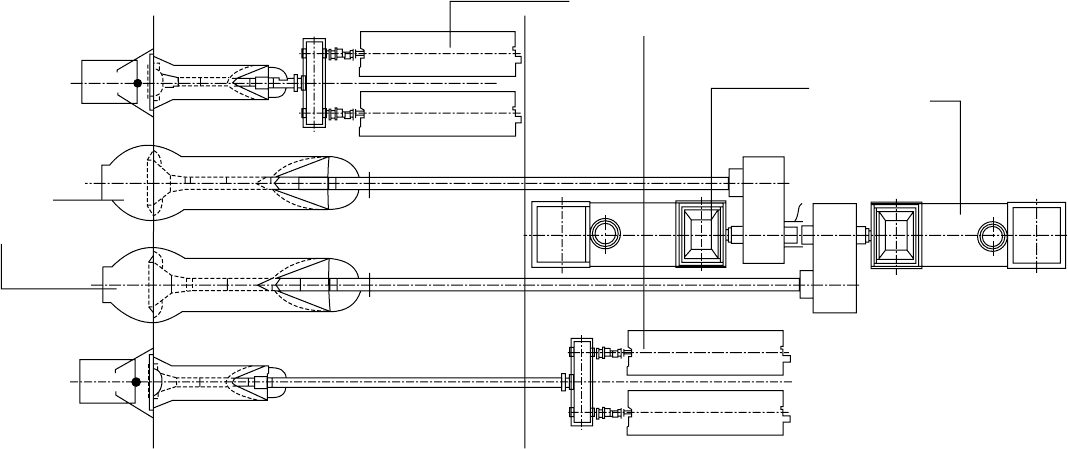
Plant congurations 831
fiGure 31.1 CoDaG propulsion plant conguration for a large monohull fast ferry
MTU engines 20V
1163 TB73 L
LM 2500 gas
turbines
Manoeuvring jet
Booster jets
Manoeuvring jet
